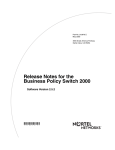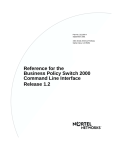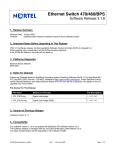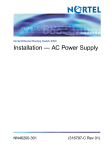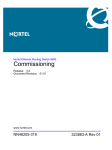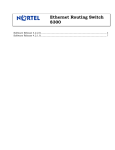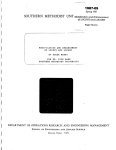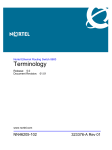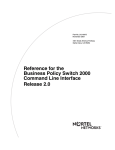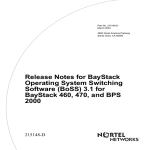Download Avaya Business Policy Switch 2000 Release 2.0.5 Release Notes
Transcript
Part No. 210676-P
June 2002
4401 Great America Parkway
Santa Clara, CA 95054
Release Notes for the
Business Policy Switch 2000
Software Version 2.0.5
*210676-P*
2
Copyright © 2002 Nortel Networks
All rights reserved. June 2002.
The information in this document is subject to change without notice. The statements, configurations, technical
data, and recommendations in this document are believed to be accurate and reliable, but are presented without
express or implied warranty. Users must take full responsibility for their applications of any products specified in
this document. The information in this document is proprietary to Nortel Networks NA Inc.
The software described in this document is furnished under a license agreement and may be used only in
accordance with the terms of that license. The software license agreement is included in this document.
Trademarks
BayStack, Business Policy Switch 2000, Nortel Networks, the Nortel Networks logo, and Optivity Policy Services
are trademarks of Nortel Networks.
Adobe and Acrobat are trademarks of Adobe Systems Incorporated.
All other trademarks and registered trademarks are the property of their respective owners.
Statement of Conditions
In the interest of improving internal design, operational function, and/or reliability, Nortel Networks NA Inc.
reserves the right to make changes to the products described in this document without notice.
Nortel Networks NA Inc. does not assume any liability that may occur due to the use or application of the
product(s) or circuit layout(s) described herein.
210676-P
3
Introduction
These release notes for the Nortel Networks* Business Policy Switch 2000*
software version 2.0.5 provide information about software and operational issues
not included in the Business Policy Switch 2000 (BPS 2000) software version 2.0
guides.
To obtain the software version 2.0.5, download the following files from the
Customer Support World Wide Web site:
•
•
bps2k205_16.img (software file)
bps2kdiag_2053.bin (diagnostics file)
You must download the diagnostics file as well as the software file.
Note: When you are downloading with a mixed (or Hybrid) stack,
ensure that a BPS 2000 switch is Unit 1 and is the base unit. Ensure that
you do not interrupt the download process; do not detach either the
power cord or any of the network connections during download.
To obtain the Java* Device Manager (DM) software to manage the BPS 2000,
download the following file from the Customer Support World Wide Web site:
•
DM 5.5.3—You must upgrade the JRE software, which is on the web site, to
version 1.3.0 at this time also.
Note: Ensure that you have upgraded to the BPS 2000 software v2.0 or
later version when you use the BPS 2000-1GT, BPS 2000-2GT, or BPS
2000-2GE MDA. You must upgrade to the BPS 2000 software v2.0 or
later version whether you are using a standalone BPS 2000, a stack of
pure BPS 2000, or a mixed stack.
Release Notes for the Business Policy Switch 2000 Software Version 2.0.5
4 Stack Operational Mode after reset
Note: When you create a policy that references shaping parameters, the
802.1p and Drop Precedence values must be changed either by using the
system defaults or explicitly by the action.
These release notes provide information on version 2.0.5 and cover the following
topics:
•
•
•
•
•
•
•
•
•
•
•
•
•
•
•
“Stack Operational Mode after reset,” next
“Upgrading software” on page 5
“Compatibility with BayStack 450 switches” on page 8
“Documentation correction” on page 9
“New features and enhancements” on page 10
“Unknown multicast frame handling enhancement” on page 12
“New Device Manager features” on page 12
“Enhanced Web-based management features” on page 18
“Enhancements to the console interface” on page 19
“New and enhanced NNCLI commands for version 2.0.5” on page 20
“Resolved issues” on page 33
“Known issues” on page 36
“Known limitations” on page 39
“Related publications” on page 41
“How to get help” on page 42
Stack Operational Mode after reset
When you reset the BPS 2000 switch to factory default settings, the Stack
Operational Mode will not be reset. You must be especially aware of this when
moving the switch between different stacks. For example, if you are working with
a stack in Hybrid mode and you move that switch to a Pure BPS 2000 stack or a
standalone configuration, you will have to manually set the Stack Operational
Mode, even if you reset the switch to factory defaults.
210676-P
Upgrading software 5
The original documentation erroneously states that the Stack Operational Mode
resets to a default value when you reset the switch to factory defaults.
Upgrading software
Note: Use the Command Line Interface (CLI), console interface (CI)
menus, or the Web-based management system to upgrade to software
version 2.0.5. For detailed instructions, refer to Using the Business
Policy Switch 2000 Version 2.0, Reference for the Business Policy Switch
2000 Command Line Interface Software Version 2.0, and Using
Web-based Management for the Business Policy Switch 2000 Software
Version 2.0.
You use one of the management systems to upgrade or downgrade software. You
follow a different procedure depending on whether you are using a Pure BPS 2000
stack or a Hybrid stack.
The stacking software compatibility requirements are as follows:
•
•
•
Pure BPS 2000 stack—All units must be running the same software version.
Pure BayStack 450 stack—All units must be running the same software
version.
Hybrid stack:
— All BPS 2000 units must be running the same software version.
— All BayStack 410 units must be running the same software version.
— All BayStack 450 units must be running the same software version.
— All software versions must have the identical ISVN.
This section discusses the following topics:
•
•
“Upgrading software in a Pure BPS 2000 stack,” next
“Upgrading software in a Hybrid stack” on page 6
Release Notes for the Business Policy Switch 2000 Software Version 2.0.5
6 Upgrading software
Upgrading software in a Pure BPS 2000 stack
To download, or upgrade, software in a Pure BPS 2000 stack:
1
Download the operational software, or agent, image.
2
Download the diagnostics image.
However, if you are currently using software version 1.0, 1.0.1, or 1.1, you must
upgrade to software version 1.1.1 before upgrading to version 2.0.5.
Note: Once you begin the upgrading process, do not interrupt the
process at all. Interrupting the downloading (or upgrading) process may
cause loss of connectivity.
Upgrading software in a Hybrid stack
The physical order of the units and the unit numbering in the Hybrid stack does
not affect the upgrading process at all. In addition, the cabling order regarding
upstream/downstream neighbors does not affect the process.
Before you attempt to download new software (or upgrade software) to a Hybrid
(mixed) stack, you must ensure that the Interoperability Software Version
Numbers (ISVN) are identical. That is, the ISVN number for the BayStack 450
switch and BayStack 410 switch must have the same ISVN as the BPS 2000. If
the ISVNs are not the same, the stack does not operate. The ISVNs and the
accompanying software release are:
•
•
210676-P
ISVN 1
— BayStack 410 or Bay Stack 450—version 3.1
— BPS 2000—versions 1.0 and 1.0.1
ISVN 2
— BayStack 410 or BayStack 450—versions 4.0, 4.1 and 4.2.
— BPS 2000—versions 1.1, 1.1.1, 1.2, 2.0, and 2.0.5
Upgrading software 7
This section describe the steps for the following software upgrades:
•
•
“Upgrading software when ISVN is 2,” next
“Upgrading software when ISVN is 1” on page 7
Upgrading software when ISVN is 2
To upgrade a Hybrid stack to BPS 2000 software version 2.0.5 when the ISVN
numbers of the units are 2:
1
Download the BPS 2000 image file.
The system resets.
2
Download the BPS 2000 diags file.
The system resets.
Note: Once you begin the upgrading process, do not interrupt the
process at all. Interrupting the downloading (or upgrading) process may
cause loss of connectivity.
Upgrading software when ISVN is 1
To upgrade a Hybrid stack to BPS 2000 software version 2.0.5 when the ISVN
numbers of the units are 1:
1
Download the BPS 2000 image file and the BayStack 450/410 file
simultaneously.
Note: If you do not download both the BPS 2000 and BayStack 410/450
images simultaneously, the stack may not form.
The system resets.
2
Download the other BayStack 450 image file.
The system resets.
3
Download the BPS 2000 diags file.
The system resets.
Release Notes for the Business Policy Switch 2000 Software Version 2.0.5
8 Compatibility with BayStack 450 switches
4
Validate that the ISVN on both the BPS 2000 and the BayStack are 2.
Note: Once you begin the upgrading process, do not interrupt the
process at all. Interrupting the downloading (or upgrading) process may
cause loss of connectivity.
Compatibility with BayStack 450 switches
The BPS 2000 software version 2.0.5 is compatible with BayStack* 450 software
versions 4.0, 4.1 and 4.2.
You can stack the BPS 2000 up to 8 units high. There are two types of stacks:
•
•
Pure BPS 2000 —This stack has only BPS 2000 switches. It is sometimes
referred to as a pure stack. The stack operational mode for this type of stack is
Pure BPS 2000 Mode.
Hybrid—This stack has a combination of BPS 2000 switches and BayStack
450 and/or BayStack 410 switches. It is sometimes referred to as a mixed
stack. The stack operational mode for this type of stack is Hybrid Stack.
All BPS 2000 switches in the stack must be running the identical version of
software, and all the BayStack switches must be running the identical version of
software.
When you are working with a mixed stack, you must ensure that the
Interoperability Software Version Numbers (ISVN) are identical. That is, the
ISVN number for the BayStack 450 switch and BayStack 410 switch must have
the same ISVN as the BPS 2000. If the ISVNs are not the same, the stack does not
operate. The ISVNs and the accompanying software release are:
•
•
210676-P
ISVN 1
— BayStack 410 or Bay Stack 450—version 3.1
— BPS 2000—versions 1.0 and 1.0.1
ISVN 2
— BayStack 10 or BayStack 450—versions 4.0, 4.1 and 4.2
— BPS 2000—versions 1.1, 1.1.1, 1.2, 2.0, and 2.0.5
Documentation correction 9
In sum, the stacking software compatibility requirements are as follows:
•
•
•
Pure BPS 2000 stack—All units must be running the same software version.
Pure BayStack 450 stack—All units must be running the same software
version.
Hybrid stack:
— All BPS 2000 units must be running the same software version.
— All BayStack 410 units must be running the same software version.
— All BayStack 450 units must be running the same software version.
— All software versions must have the identical ISVN.
To find out which version of the BPS 2000 software is running, use the Console
Interface (CI) menus or the Web-based management system:
•
•
CI menus—From the main menu of the Console, choose Systems
Characteristics menu. The software currently running is displayed in
sysDescr.
Web-based management system—Open the System Information page, which
is under Administration on the main menu. The software currently running is
displayed in the sysDescription field.
Refer to Appendix B of the Using the Business Policy Switch 2000 Software
Version 2.0 for complete information on interoperability and compatibility
between the BPS 2000 and BayStack switches.
Although the BPS 2000 software version 2.0.5 is compatible with BayStack 450
software versions 4.0 and 4.1, when you operate a mixed stack of BPS 2000 and
BayStack 450 switches, some of the BayStack 450 software version 4.1 and 4.2
enhancements may not be accessible.
Documentation correction
Autonegotiation can be enabled on every supported fiber optic MDA except the
BPS2000-2GE MDA. The previous documentation for BPS 2000 erroneously
states that you cannot enable autonegotiation for any fiber optic port.
Release Notes for the Business Policy Switch 2000 Software Version 2.0.5
10 New features and enhancements
New features and enhancements
The following new features and enhancements are offered with the BPS 2000
software version 2.0.5:
•
Support for Far End Fault Indication (FEFI)—When a fiber optic
transmission link to a remote device fails, the remote device indicates the
failure and the port is disabled. To use FEFI, you must enable autonegotiation
on the port.
Note: FEFI will not work with the BPS 2000-2GE MDA because the
BPS 2000-2GE MDA does not support autonegotiation.
•
•
•
•
•
•
•
•
•
210676-P
Increased support from 40 to 150 RMON alarms
CLI support for RMON—See “New and enhanced NNCLI commands for
version 2.0.5” on page 20 for a description of the new commands.
SNMP support for downloading ASCII configuration files
Settable Multicast MAC address for Spanning Tree Groups (STG)
— Refer to “New and enhanced NNCLI commands for version 2.0.5” on
page 20 for instructions on using this feature using the CLI.
— Refer to “Enhanced Web-based management features” on page 18 for
instructions on using this feature with Web-based management.
— Refer to “Enhancements to the console interface” on page 19 for
instructions on using this feature with the console interface.
SNMP support for downloading diagnostics—See “New Device Manager
features” on page 12.
Device Manager enhancements—See “New Device Manager features” on
page 12 for a description of the enhancements.
Support for IGMP FAST LEAVE in Hybrid mode
Unknown multicast frame handling enhancement
— Refer to “Unknown multicast frame handling enhancement” on page 12
for explanation of this feature.
— Refer to “New and enhanced NNCLI commands for version 2.0.5” on
page 20 for instructions on using this feature using the CLI.
BPS 2000-2GE MDA laser turned off when port disabled
New features and enhancements 11
•
•
•
•
•
CLI enhancement for clearing Common Open Policy Services (COPS) server
table—See “New and enhanced NNCLI commands for version 2.0.5” on
page 20 for a description of the new command.
Cannot enter broadcast address for MAC DA filtering
CLI enhancement for saving configuration to NVRAM—See “New and
enhanced NNCLI commands for version 2.0.5” on page 20 for a description
of the new command.
CLI enhancement for removing all VLANs—See “New and enhanced NNCLI
commands for version 2.0.5” on page 20 for a description of the new
command.
BPS 2000 Image If Newer option added to the software download menu—If a
newer image file is found, it will be downloaded and the switch will reset
when the download process finishes successfully. Support for this feature has
been added to the CLI, console, SNMP and Web-management.
The following new features and enhancements are offered with the BPS 2000
software version 2.0:
•
•
•
•
•
•
•
•
•
•
•
Enhancement to BootP mode—Beginning with software version 2.0, the
BootP or Last Address mode of BootP will always BootP for its IP
configuration, regardless of whether a configured IP address is present, when
the Stack BootP Mac Address Type is set to Base Unit Mac Address. If BootP
is successful, the retrieved IP parameters are used by the switch or stack. The
retrieved IP parameters are copied to the Last BootP IP parameters and
overwrite any user-configured IP parameters. This feature applies only to a
standalone BPS 2000 unit or to a stack consisting only of BPS 2000 units with
the Stack Operational Mode set to Pure BPS 2000 Stack.
Support for BPS 2000-1GT, BPS 2000-2GT, and BPS 2000-2GE MDAs
QoS rate shaping
No longer need to configure QoS meters if not metering traffic
Improved QoS Wizard Web configuration pages
QoS Quick Config Web configuration pages
QoS filtering of multiple VLANs per Layer 2 filter
Configurable VID for tagged STP BPDUs
IP address for each switch in a stack
MAC destination address (DA) filtering
Port naming
Release Notes for the Business Policy Switch 2000 Software Version 2.0.5
12 Unknown multicast frame handling enhancement
•
•
QoS policy enable or disable
Enhanced Web QoS error reporting
Unknown multicast frame handling enhancement
By default, unknown multicast traffic is flooded to all ports in a VLAN. In
situations where there is a multicast transmitter that is not doing IGMP and there
are no multicast receivers, the traffic transmitted by the transmitter is flooded.
The new IGMP unknown mcast no flood CLI commands included in software
version 2.0.5 allow you to send all unknown multicast traffic to IGMP static
router ports only. This traffic will not be forwarded to dynamically discovered
mrouter ports. If you want to forward unknown unicast traffic to certain ports
only, you can set those ports as static mrouter ports.
•
•
•
•
When disabled, BPS 2000 will treat unknown multicast traffic like broadcast
traffic (flood). This is the default behavior.
User setting for the unknown mcast no flood feature will be stored in
NVRAM. In a stack, if settings on different units differ, Base Unit setting will
take precedence. This feature can be enabled or disabled at any time.
In a mixed BPS 2000/BayStack 450 stack, the unknown mcast no flood
feature, if enabled, will take effect only on BPS 2000s. BayStack 450s will
still flood unknown multicast traffic. Enabling this feature is not
recommended in a mixed BPS 2000/BayStack 450 stack.
It is suggested that this feature be used when IGMP snooping is enabled.
Refer to “IGMP CLI commands” on page 31 for a description of the new IGMP
CLI commands for the unknown mcast no flood feature.
New Device Manager features
This section discusses the new Device Manager features included in software
version 2.0.5 and covers the following topics:
•
•
210676-P
“Device status within a stack,” next
“The management VLAN ID” on page 14
New Device Manager features 13
•
•
•
•
“Base unit IP address” on page 15
“IP addresses for the stack” on page 15
“Designating the diagnostics file” on page 16
“Downloading the ASCII config file” on page 16
Device status within a stack
The Device Manager will display devices that are down in a stack (Figure 1).
Figure 1 Device view
Release Notes for the Business Policy Switch 2000 Software Version 2.0.5
14 New Device Manager features
The management VLAN ID
You can now view the management VLAN ID in the System tab of the Edit
Chassis dialog box (Figure 2).
Figure 2 Edit Chassis dialog box—System tab
210676-P
New Device Manager features 15
Base unit IP address
You can now view the Base Unit IP address in the Base Unit Info tab of the Edit
Chassis dialog box (Figure 3).
Figure 3 Edit Chassis dialog box—Base Unit Info tab
IP addresses for the stack
You can now view the IP addresses for the stack in the Stack Info tab of the Edit
Chassis dialog box (Figure 4).
Figure 4 Edit Chassis dialog box—Stack Info tab
Release Notes for the Business Policy Switch 2000 Software Version 2.0.5
16 New Device Manager features
Designating the diagnostics file
You can now select the diagnostics file that is associated with the device in the
Config/Image/Diag file tab of the Edit File System dialog box (Figure 5).
Figure 5 Edit File System dialog box—Config/Image/Diag file tab
Downloading the ASCII config file
To select the ASCII config file download options:
1
From the Device Manager menu bar, choose Edit > File System.
The File System dialog box opens with the Config/Image/Diag file tab
displayed.
2
Click the Ascii Config File tab.
The Ascii Config File tab opens (Figure 6).
210676-P
New Device Manager features 17
Figure 6 Edit File System dialog box—Ascii Config File tab
Table 1 describes the Ascii Config File tab fields.
Table 1 Ascii Config File tab fields
Field
Description
LoadServerAddr
Set the server address.
AsciiConfigFilename
Set the ASCII config filename.
AsciiConfigAutoDownload
The current ASCII config file download setting, which
can be one of the following:
• disabled
• useBootp
• useConfig
If set to disabled, the device will not automatically
download the ASCII config file.
AsciiConfigAutoDldStatus
Shows the status of the ASCII config file download.
AsciiConfigManualDownload
If downloadNow is selected, the ASCII config file will be
downloaded immediately. Otherwise, download status is
displayed.
Release Notes for the Business Policy Switch 2000 Software Version 2.0.5
18 Enhanced Web-based management features
Enhanced Web-based management features
This section discusses the enhanced Web-based management features included in
software version 2.0.5 and covers the following topics:
•
“Setting the STG multicast MAC address,” next
Setting the STG multicast MAC address
You can now set the STG multicast MAC address in the Application > Spanning
Tree > Group Configuration window (Figure 7).
Figure 7 Group Configuration window
210676-P
Enhancements to the console interface 19
Enhancements to the console interface
This section discusses the enhanced console interface features included in
software version 2.0.5 and covers the following topic:
•
“Setting the STG multicast MAC address,” next
Setting the STG multicast MAC address
You can now set the STG multicast MAC address in the Main Menu > Spanning
Tree Configuration > Spanning Tree Group Configuration menu (Figure 8).
Figure 8 Spanning Tree Group Configuration menu
Spanning Tree Group Configuration
Create STP Group:
Delete STP Group:
Bridge Priority:
Bridge Hello Time:
Bridge Max. Age Time:
Bridge Forward Delay Time:
Add
VLAN Membership:
Delete VLAN Membership:
Tagged BPDU on tagged port:
VID used for Tagged BPDU:
STP Multicast Address:
STP Group State:
[
[
[
[
[
[
[
[
[
[
[
[
1 ]
]
8000 ]
2 seconds ]
20 seconds ]
15 seconds ]
1 ]
]
No ]
4001 ]
01-80-c2-00-00-00 ]
Active
]
Use space bar to display choices, press <Return> or <Enter> to select choice.
Press Ctrl-R to return to previous menu. Press Ctrl-C to return to Main Menu.
Release Notes for the Business Policy Switch 2000 Software Version 2.0.5
20 New and enhanced NNCLI commands for version 2.0.5
New and enhanced NNCLI commands for version 2.0.5
This section discusses the new and enhanced NNCLI commands included in
software version 2.0.5 and covers the following topics:
•
•
•
•
•
•
“Setting the STG multicast MAC address,” next
“Saving configuration to NVRAM” on page 21
“Common Open Policy Services (COPS)” on page 22
“Removing VLANs” on page 22
“RMON CLI commands” on page 23
“IGMP CLI commands” on page 31
Setting the STG multicast MAC address
The following command has been enhanced to allow setting of the STG multicast
MAC address in software version 2.0.5:
spanning-tree
The spanning-tree command allows you to configure the spanning tree
protocol. The syntax for the spanning-tree command is:
spanning-tree [stp <1-8>] [forward-time <4-30>] [hello-time
<1-10>] [max-age <6-40>] [priority <0-65535>] [tagged-bdpu
{enable|disable}] [tagged-bdpu-vid <1-4094>]
[multicast-address <H.H.H>]
The spanning-tree command is in the config command mode.
Table 2 describes the parameters and variables for the spanning-tree
command.
Table 2 spanning-tree command parameters and variables
Parameters and variables
210676-P
Description
stp <1-8>
Spanning tree group ID.
forward-time <4-30>
Set forward time.
New and enhanced NNCLI commands for version 2.0.5 21
Table 2 spanning-tree command parameters and variables (continued)
Parameters and variables
Description
hello-time <1-10>
Set hello time.
max-age <6-40>
Set maximum age.
priority <0-65535>
Set priority.
tagged-bdpu {enable|disable}
Enable/disable tagged BPDUs on tagged ports.
tagged-bdpu-vid <1-4094>
Set VLAN ID for tagged BPDUs
multicast-address <H.H.H>
Set spanning-tree multicast address.
Saving configuration to NVRAM
The following new command for saving configuration to NVRAM is offered with
the BPS 2000 software version 2.0.5:
copy config nvram
The copy config nvram copies the current configuration to NVRAM. The
syntax for the copy config nvram command is:
copy config nvram
The copy config nvram command is in the privExec command mode.
The copy config nvram command has no parameters or variables.
Note: The copy config nvram command is also periodically
performed automatically
Release Notes for the Business Policy Switch 2000 Software Version 2.0.5
22 New and enhanced NNCLI commands for version 2.0.5
Common Open Policy Services (COPS)
The following command been enhanced in BPS 2000 software version 2.0.5 to
allow the entire COPS server table to be cleared:
no cops server
The no cops server command removes COPS server configuration. When the
variable is omitted, the entire COPS server table is cleared. The syntax for the no
cops server command is:
no cops server [<A.B.C.D>]
The no cops server command is in the config command mode.
Table describes the parameters and variables for the no cops server
command.
Table 3 no cops server command parameters and variables
Parameters and variables
<A.B.C.D>
Description
Enter the IP address of the COPS server you want to
clear. Omitting this variable will clear the entire COPS
server table.
Removing VLANs
The following command has been enhanced in BPS 2000 software version 2.0.5
to allow the removal of all VLANs:
no vlan
The no vlan command used with the variable omitted removes all VLANs. The
syntax for the no vlan command is:
no vlan [<2-4094>]
Note: VLAN ID 1, the default management VLAN, cannot be deleted.
210676-P
New and enhanced NNCLI commands for version 2.0.5 23
The no vlan command is in the config command mode.
Table 4 describes the parameters and variables for the no vlan command.
Table 4 no vlan command parameters and variables
Parameters and variables
<2-4094>
Description
ID of the VLAN to be removed. Omitting this variable will
remove all VLANs except for VLAN 1, which cannot be
deleted.
RMON CLI commands
This sections discusses the following new RMON CLI commands that are
included in software version 2.0.5. and covers the following topics:
•
•
•
•
•
•
•
•
•
•
•
•
“show rmon alarm,” next
“show rmon event” on page 24
“show rmon history” on page 24
“show rmon stats” on page 25
“rmon alarm” on page 26
“no rmon alarm” on page 27
“rmon event” on page 28
“no rmon event” on page 28
“rmon history” on page 29
“no rmon history” on page 30
“rmon stats” on page 30
“no rmon stats” on page 31
show rmon alarm
The show rmon alarm command displays information for RMON alarms. The
syntax for the show rmon alarm command is:
show rmon alarm
Release Notes for the Business Policy Switch 2000 Software Version 2.0.5
24 New and enhanced NNCLI commands for version 2.0.5
The show rmon alarm command is in the privExec mode.
The show rmon alarm command has no parameters or variables. Figure 9
displays a sample output of the show rmon alarm command.
Figure 9 show rmon alarm command output
BPS2000#show rmon alarm
Sample
Rising
Falling
Index Interval Variable
Type Threshold Event Threshold Event
----- -------- ------------------------- ------ --------- ----- --------- ----1
30
ifInOctets.1
delta 500
1
10
1
show rmon event
The show rmon event command displays information regarding RMON
events. The syntax for the show rmon event command is:
show rmon event
The show rmon event command is in the privExec mode.
The show rmon event command has no parameters or variables. Figure 10
displays a sample output of the show rmon event command.
Figure 10 show rmon event command output
BPS2000#show rmon event
Index Log Trap Description
----- --- ---- ---------------------------------------------------1
Yes Yes ‘Rising or Falling alarm on received octets’
show rmon history
The show rmon history command displays information regarding RMON
history. The syntax for the show rmon history command is:
show rmon history
210676-P
New and enhanced NNCLI commands for version 2.0.5 25
The show rmon history command is in the privExec mode.
The show rmon history command has no parameters or variables.
Figure 11 displays a sample output of the show rmon history command.
Figure 11 show rmon history command output
BPS2000#show rmon history
Index Unit/Port Buckets Requested
----- --------- ----------------1
1/1
15
2
1/2
15
3
1/3
15
4
1/4
15
5
1/5
15
6
1/6
15
7
1/7
15
8
1/8
15
9
1/9
15
10
1/10
15
11
1/11
15
12
1/12
15
13
1/13
15
14
1/14
15
15
1/15
15
16
1/16
15
17
1/17
15
18
1/18
15
19
1/19
15
20
1/20
15
--More--
Buckets Granted
--------------15
15
15
15
15
15
15
15
15
15
15
15
15
15
15
15
15
15
15
15
Interval
-------30
30
30
30
30
30
30
30
30
30
30
30
30
30
30
30
30
30
30
30
show rmon stats
The show rmon stats command displays information regarding RMON
statistics. The syntax for the show rmon stats command is:
show rmon stats
The show rmon stats command is in the privExec mode.
Release Notes for the Business Policy Switch 2000 Software Version 2.0.5
26 New and enhanced NNCLI commands for version 2.0.5
The show rmon stats command has no parameters or variables. Figure 12
displays a sample output of the show rmon stats command.
Figure 12 show rmon stats command output
BPS2000#show rmon stats
Index Unit/Port
----- --------1
1/1
2
1/2
3
1/3
4
1/4
5
1/5
6
1/6
7
1/7
8
1/8
9
1/9
10
1/10
11
1/11
12
1/12
13
1/13
14
1/14
15
1/15
16
1/16
17
1/17
18
1/18
19
1/19
20
1/20
--More--
rmon alarm
The rmon alarm command allows you to set RMON alarms and thresholds. The
syntax for the rmon alarm command is:
rmon alarm <1-65535> <WORD> <1-2147483647> {absolute|delta}
rising threshold <-2147483648-2147483647> [<1-65535>]
falling-threshold <-2147483648-2147483647> [<1-65535>]
[owner <LINE>]
The rmon alarm command is in the config command mode.
210676-P
New and enhanced NNCLI commands for version 2.0.5 27
Table 5 describes the parameters and variables for the rmon alarm command.
Table 5 rmon alarm command parameters and variables
Parameters and variables
Description
<1-65535>
Unique index for the alarm entry.
<WORD>
The MIB object to be monitored. This is an OID, and for
most available objects, an English name may be used.
<1-2147483647>
The sampling interval, in seconds.
absolute
Use absolute values (value of the MIB object is
compared directly with thresholds).
delta
Use delta values (change in the value of the MIB object
between samples is compared with thresholds).
rising-threshold
<-2147483648-2147483647>
[<1-65535>]
The first integer value is the rising threshold value. The
optional second integer specifies the event entry to be
triggered when the rising threshold is crossed. If omitted,
or if an invalid event entry is referenced, no event will be
triggered.
falling-threshold
<-2147483648-2147483647>
[<1-65535>]
The first integer value is the falling threshold value. The
optional second integer specifies the event entry to be
triggered when the falling threshold is crossed. If
omitted, or if an invalid event entry is referenced, no
event will be triggered.
[owner <LINE>]
Specify an owner string to identify the alarm entry.
no rmon alarm
The no rmon alarm command turns off the RMON alarms. When the variable is
omitted, all entries in the table are cleared. The syntax for the no rmon alarm
command is:
no rmon alarm [<1-65535>]
The no rmon alarm command is in the config command mode.
Release Notes for the Business Policy Switch 2000 Software Version 2.0.5
28 New and enhanced NNCLI commands for version 2.0.5
Table 6 describes the parameters and variables for the no rmon alarm
command.
Table 6 no rmon alarm command parameters and variables
Parameters and variables
<1-65535>
Description
Unique index for the alarm entry.
rmon event
The rmon event allows you to configure RMON event log and trap settings. The
syntax for the rmon event command is:
rmon event <1-65535> [log] [trap] [description <LINE>]
[owner <LINE>]
The rmon event command is in the config command mode.
Table 7 describes the parameters and variables for the rmon event command.
Table 7 rmon event command parameters and variables
Parameters and variables
Description
<1-65535>
Unique index for the event entry.
[log]
Record events in the log table.
[trap]
Generate SNMP trap messages for events.
[description <LINE>]
Specify a textual description for the event.
[owner <LINE>]
Specify an owner string to identify the event entry
no rmon event
The no rmon event turns off RMON event log and trap settings. When the
variable is omitted, all entries in the table are cleared. The syntax for the no rmon
event command is:
no rmon event [<1-65535>]
210676-P
New and enhanced NNCLI commands for version 2.0.5 29
The no mon event command is in the config command mode.
Table 8 describes the parameters and variables for the no rmon event
command.
Table 8 no rmon event command parameters and variables
Parameters and variables
<1-65535>
Description
Unique index for the event entry.
rmon history
The rmon history allows you to configure RMON history settings. The syntax
for the rmon history command is:
rmon history <1-65535> <LINE> <1-65535> <1-3600> [owner
<LINE>]
The rmon history command is in the config command mode.
Table 9 describes the parameters and variables for the rmon history command.
Table 9 rmon history command parameters and variables
Parameters and variables
Description
<1-65535>
Unique index for the history entry.
<LINE>
Specify the port number to be monitored.
<1-65535>
The number of history buckets (records) to keep.
<1-3600>
The sampling rate (how often a history sample is
collected).
[owner <LINE>]
Specify an owner string to identify the history entry.
Release Notes for the Business Policy Switch 2000 Software Version 2.0.5
30 New and enhanced NNCLI commands for version 2.0.5
no rmon history
The no rmon history turns off RMON history. When the variable is omitted,
all entries in the table are cleared. The syntax for the no rmon history
command is:
no rmon history [<1-65535>]
The no rmon history command is in the config command mode.
Table 10 describes the parameters and variables for the no rmon history
command.
Table 10 no rmon history command parameters and variables
Parameters and variables
<1-65535>
Description
Unique index for the history entry.
rmon stats
The rmon stats command allows you to configure RMON statistics settings.
The syntax for the rmon stats command is:
rmon stats <1-65535> <LINE> [owner <LINE>]
The rmon stats command is in the config command mode.
Table 11 describes the parameters and variables for the rmon stats command.
Table 11 rmon stats command parameters and variables
Parameters and variables
210676-P
Description
<1-65535>
Unique index for the stats entry.
[owner <LINE>]
Specify an owner string to identify the stats entry.
New and enhanced NNCLI commands for version 2.0.5 31
no rmon stats
The no rmon stats turns off RMON statistics. When the variable is omitted, all
entries in the table are cleared. The syntax for the no rmon stats command is:
no rmon stats [<1-65535>]
The no rmon stats command is in the config command mode.
Table 12 describes the parameters and variables for the no rmon stats
command.
Table 12 no rmon stats command parameters and variables
Parameters and variables
<1-65535>
Description
Unique index for the stats entry.
IGMP CLI commands
This sections discusses the following new IGMP CLI commands that are included
in software version 2.0.5. and covers the following topics:
•
•
•
“vlan igmp unknown-mcast-no-flood,” next
“show vlan igmp” on page 32
“default vlan igmp unknown-mcast-no-flood” on page 33
vlan igmp unknown-mcast-no-flood
The vlan igmp unknown-mcast-no-flood command allows the user to
block flooding of packets with unknown multicast address. Instead, the unknown
multicast traffic will be sent only to IGMP static router ports. The syntax for the
vlan igmp unknown-mcast-no-flood command is:
vlan igmp unknown-mcast-no-flood
The vlan igmp unknown-mcast-no-flood command is in the config
command mode.
Release Notes for the Business Policy Switch 2000 Software Version 2.0.5
32 New and enhanced NNCLI commands for version 2.0.5
Table 13 describes the parameters and variables for the vlan igmp
unknown-mcast-no-flood command.
Table 13 vlan igmp unknown-mcast-no-flood command parameters and
variables
Parameters and variables
Description
enable
Enables flooding of packets with unknown multicast
addresses.
Note: The default parameter is enabled.
disable
Disables flooding of packets with unknown multicast
addresses.
show vlan igmp
The show vlan igmp command displays whether flooding of packets with
unknown multicast addresses is enabled or disabled. The syntax for the show
vlan igmp command is:
show vlan igmp {unknown-mcast-no-flood|<1-4094>}
The show vlan igmp command is in the privExec command mode.
Table 14 describes the parameters and variables for the show vlan igmp
command.
Table 14 show vlan igmp command parameters and variables
Parameters and variables
Description
unknown-mcast-no-flood
Displays whether flooding of packets with unknown
multicast addresses is enabled or disabled.
<1-4094>
Displays IGMP setting for specified VLAN ID.
Figure 13 displays a sample output of the show vlan igmp command.
210676-P
Resolved issues 33
Figure 13 show vlan igmp command output
BPS2000#show vlan igmp unknown-mcast-no-flood
Unknown Multicast No-Flood: Disabled
default vlan igmp unknown-mcast-no-flood
The default vlan igmp unknown-mcast-no-flood command enables
flooding of packets with unknown multicast address. The syntax for the default
vlan igmp unknown-mcast-no-flood command is:
default vlan igmp unknown-mcast-no-flood
The default vlan igmp unknown-mcast-no-flood command is in the
privExec command mode.
The default vlan igmp unknown-mcast-no-flood command has no
parameters or variables.
Resolved issues
The following issues were resolved in version 2.0.5:
•
•
•
•
•
•
When configuring Port Mirroring on a specified MAC address, resetting the
switch no longer causes instabilities in the system. (CR Q00155176)
When deleting a VLAN member of a Spanning Tree Group (STG), the first
port of the MLT is now correctly removed from the STG. (CR Q00316370)
You no longer need to reboot the BPS 2000 switch when you add a policy
where you configure shaping parameters. (CR Q00139108)
When using Web management on a stack of BPS 2000 switches and accessing
the Port Error Summary page, if the page contains more than six entries, the
system will no longer hang. (CR Q00170933)
The command dot1dStpPortEnable.x now works properly to disable a
port. (CR Q00391212)
The Redundant Power Supply Unit (RPSU) LED no longer returns the wrong
value when using Device Manager. (CR Q00279588)
Release Notes for the Business Policy Switch 2000 Software Version 2.0.5
34 Resolved issues
•
•
•
•
•
•
•
•
•
•
You can now log in via the Web interface using RADIUS authentication.
(CR Q00416483)
You can now use the CLI to configure flow control for BPS 2000-2GE ports.
(CR Q00415228)
When autonegotiation is enabled for a Gigabit link, the flow control menu in
the Web interface no longer offers the choice of Symmetric or Asymmetric.
Flow control is disabled. (CR Q00416485)
Sixteen character usernames cause RADIUS authentication to fail. Web and
console interface now correctly limit usernames to 15 characters for RADIUS
authentication. (CR Q00359668)
The show port-statistics command has been added to all command
modes. It was previously available only in the interface configuration mode.
(CR Q00310716)
In a Hybrid stack, when a station is moved to a different VLAN, it will
properly communicate with the new VLAN (CR Q00384459)
STP will now be correctly disabled on the monitor port when port mirroring is
enabled. (CR Q00415229)
If the connection is interrupted during the download of the diagnostics code,
the switch will not try to use the incomplete diagnostics. (CR Q00417287)
Timing issues during switch resets have been corrected so that large
BPS 2000 stacks will no longer go into a loop when switches are reset.
(CR Q00251306)
The default global filter only applies to Ethernet II encapsulated packets.
Default and customer-configured global filters can no longer corrupt IEEE
802.3 or SNAP (Subnetwork Access Protocol) encapsulated packets by
modifying the Differentiated Services Code Point (DSCP) of the packets.
(CR Q00230928)
Note: You cannot modify the DSCP of IEEE 802.3 or SNAP
encapsulated packets.
The following issues were resolved in version 2.0.2.3:
•
210676-P
The allowable ranges for QoS Meter Committed Rate, Max Burst Rate, and
Max Burst Duration in the CLI now correctly match the Web-based
management ranges. (CR Q00209291)
Resolved issues 35
•
Malformed SNMP message packets are now discarded. These packets can no
longer cause the SNMP task to crash, disabling SNMP, CLI and Web access.
The BPS 2000 will no longer be affected by SNMP vulnerability issues
documented on February 12, 2002 by CERT/CC in their SNMP advisory
(VU#107186 and VU#854306).
The following issues were resolved in version 2.0:
•
•
•
•
•
•
•
•
The show log and clear log CLI commands now function correctly. (CR
Q00047028)
The Web-based management system now correctly displays all configured
VLANs. (CR Q00101635)
IGMP Proxy now works correctly on tagged ports with multiple VLANs in
multiple spanning tree groups. (CR Q00084861)
It no longer takes a long time for the ASCII config file with extensive
configurations to complete. (CR Q00091334)
The flash synchronization was every 60 seconds. This synchronization now
occurs very 2 minutes and 30 seconds.
The setting of Learn by Ports in the MAC address-based security no longer
changes to disabled after you reset the switch or stack. (CR Q00147573,
Q00043550)
You can now ping the switch if the MAC address-based learning security
setting for the management port is set to Enabled. (CR Q0008448)
The BPS 2000 switch no longer caches RADIUS responses (so that
connections were authorized even when server is down). (CR Q00043170)
The stack stability was greatly enhanced in version 1.1.1.
The following issues were resolved in version 1.1:
•
You can download BayStack 410 and BayStack 450 software images (and
diagnostics) using the Device Manager in a mixed stack environment with
Business Policy Switches.
Using DM with a mixed stack and you choose Edit > File System, you can
specify either the image for the BPS 2000 or the image for the BayStack, or
both to download the software image(s).
•
The BootP timeout for the BPS is now set to five minutes, which matches the
BootP timeout value for the BayStack 450 switch. (CR 13161-1)
Release Notes for the Business Policy Switch 2000 Software Version 2.0.5
36 Known issues
•
BootP values set to either Always or When Needed are retained during a
switch reset. (CR 126842-1)
The following issue was resolved in version 1.0.1:
•
The ports on the BPS2000-4 TX MDA now autonegotiate correctly to
100 Mb/s full-duplex when they are connected to another BPS2000 port
configured to autonegotiate.
Known issues
The following paragraphs discuss the known issues with the BPS 2000.
The following issues are known to exist in version 2.0.5 of the BPS 2000
software:
•
•
When upgrading to 2.0.5 from 1.x, telnet access will be enabled, even if it was
disabled before the upgrade. You must disable telnet access again, after the
upgrade. (CR Q00391178)
When you set a large number of RMON alarms, setting a short sampling
interval for each alarm will cause the switch appear to be locked up as all
CPU resources will be used to attempt the samples.(CR Q00411371)
The workaround is to set larger sampling intervals for RMON alarms.
•
•
•
•
•
210676-P
The QoS shaping feature does not work in a stacked configuration; it works
only in a BPS 2000 standalone unit. (CR Q00153202)
QoS shaping is supported only on IP filters.
The BPS 2000 Image If Newer option added to the software download menu
does not work in a mixed stack. The download will fail with a message that
the image is not newer.
If STP is disabled for a switch, some DMLT ports may show incorrect
Spanning Tree participation settings. (CR Q00425777)
The CPU/Memory Utilization feature is unavailable in version 2.0.5
(CR Q00169353)
Known issues 37
•
When you are working with a mixed stack and download the v.2.0.x software
for the BPS 2000 and the v.4.1.x software for the BayStack 450
simultaneously, the software may not load on all units.
The workaround is to download the software separately to the BPS 2000 units
and to the BayStack 450 units. The units reset after the software downloads in
both cases.
•
•
•
•
•
The flooded packets and filtered packets counters return incorrect results for
the BPS 2000-1GT, BPS 2000-2GT, and BPS 2000-2GE MDA (they always
display 0). (CR Q00137290)
Nortel Networks recommends that you do not use MAC Address Security
(BaySecure) on any MultiLink Trunk ports.
When you renumber a stack of pure BPS 2000, check the port mirroring
configuration. You may have to manually reconfigure the ports you want for
port mirroring. (CR Q00156278)
ASCII configuration file name maximum string length is 29, rather than 30,
characters. (CRQ00107944)
When you attempt to save the configuration to the TFTP server, it may not
work the first time. (CR Q00153972)
Workaround is to save it a second time, when it definitely saves.
•
•
•
When you are using the CLI and attempt to set a 10/100 Mbps port to
1000 Mbps, the port mode resets to autonegotiation. (CR Q00153171)
When you set the Authentication Trap and Autotopology to disabled and save
the configuration file to the TFTP server, these two settings are not saved.
(CR Q00153286)
Before upgrading to BPS 2000 software version 1.2, save the software version
1.1 configuration as a binary configuration file in case you need to downgrade
to software version 1.1.
Note: If you need to downgrade from BPS 2000 software version 1.2,
save the configuration as a binary configuration file. The configuration
files will be set to factory defaults as part of the downgrade process.
Release Notes for the Business Policy Switch 2000 Software Version 2.0.5
38 Known issues
•
If you are working with a mixed, or Hybrid, stack and are downgrading the
software, the BPS 2000 units will reset to factory default but the BayStack
450 units will not default.
The workaround is to default the entire stack.
•
•
•
•
When you are working with QoS configurations and you delete a filter, that
filter will continue to operate until you reset the BPS 2000. (CR Q00071760)
When working in a mixed stack with BayStack 450 v.4.0/4.1 and BPS 2000,
only the BPS 2000 displays the IP address of the stack.
(CR Q00079143)
When using the CLI and entering the IP address and mask in the form of
A.B.C.D/<0-32>, you can also enter the values in the form of
A.B.C.D/E.F.G.H.
Occasionally when you have disabled MAC address-based security, the ports
will still register as an intrusion. (CR Q00092007, Q00091998)
The workaround is to reset the stack.
•
The port speed and duplex you set using the ASCII configuration file may
show incorrectly in the console display that shows port speed and duplex. The
actual speed and duplex will be what you set with the configuration file, but
the console display for these parameters may be incorrect. (CR Q00083014)
The workaround is to use the CLI.
•
•
When you are using DM to display the spanning tree group memberships, the
port members may not display correctly. (CR Q00093350) Use the console
interface (CI) menus, the CLI, or the Web-based management system to
double-check the spanning tree group memberships.
EAP configuration changes made at one console or using DM may not
automatically display on other consoles. (CR Q00044484, CR Q00045315)
The workaround is refresh the console and the correct data displays.
•
If you rapidly add and delete VLANs (more than 1 per second) using DM,
some of the VLANs may not be configured.
The workaround is allow a few seconds to elapse between adding and deleting
ports and VLANs if you are using DM.
•
The ASCII configuration file does not support multiple spanning tree
operations. (CR Q00088185)
Use the CI menus, CLI, the Web-based management system, or DM to
configure multiple spanning tree groups.
210676-P
Known limitations 39
The following issues are known to exist in version 1.1 of the BPS 2000 software:
•
•
•
•
•
The Multicast Group Membership table may display duplicate entries when
the switch is in Distributed MultiLink Trunking (D-MLT) mode. However,
the trunks function properly; this is a display problem only. (CR 138095-1)
In a BPS 2000-only stack, the entire stack is reset to default values when you
return the base unit to default values. (CR 145501-1)
To disable a port that is part of a MultiLink Truck (MLT) group, use either
Device Manager (DM) or the Console Interface (CI) management system
menus (you can use the Telnet connection). With the Web-based management
system, you may be unable to disable ports that are part of MLTs. (CR
146607-1)
When the High Speed Flow Control Autonegotiation feature is set to enabled
(the default), the port only advertises support for 1000 Mb/s operation, in
full-duplex mode. If you experience problems between the Business Policy
Switch and other network devices, set Autonegotiation to disabled on both
sides of the link.
Gigabit MDA
— When viewing Active Phy information from the console interface, the
console must be connected to the unit containing the Gigabit MDA (the
BayStack 450-1SR MDA and the BayStack 450-1LLR MDA) to display
the appropriate Phy information. Incorrect information may be displayed
if you connect to a unit not containing a Gigabit MDA.
— When you remove a Gigabit MDA from a switch, the Active Phy of the
effected unit displays the new status. However, occasionally, the Active
Phys of the other units in the stack or remote units will not display the
new status.
Known limitations
The following limitations are known to exist:
•
The current usable filters with software version 2.0.5 for the BPS are:
— 200 policies
— 100 interface groups
— 200 IP filters and filter groups
Release Notes for the Business Policy Switch 2000 Software Version 2.0.5
40 Known limitations
—
—
—
—
—
24 IP filters with same Source Address (18 nested subnets)
14 Layer 2 filters and filter groups
200 meters
128 actions
62 shapers
Note: Each in-profile action, out-of-profile action, and statistics
tracking session uses 1 filter each.
•
Mixed stacks (hybrid stacks)—In order to upgrade BayStack 410 and
BayStack 450 software in a hybrid stack, the stack must be fully redundant.
All cables in the stack must be installed and operating properly. If the cables
are not installed properly, the BayStack units will fail to upgrade. A message
is displayed on consoles connected to BayStack 410 and BayStack 450
switches: Primload Error - 2009 Switch will reset in 5
seconds...
•
You can configure protocol-based VLANs, with a sum total of “N” PID
values not to exceed 14 (Table 15). If you are not running the spanning tree
protocol, you have 15 PIDs available.
Table 15 Protocol and PID values
Protocol Name
210676-P
Number of PID values (N)
Ip Ether2
2
Ipx 802.3
1
Ipx 802.2
1
Ipx Snap
2
Ipx Ether2Snap
2
AplTk Ether2Snap
2
Declat Ether2
1
DecOther Ether 2
10
Sna 802.2
2
Sna Ether2
1
NetBios 802.2
2
Xns Ether2
2
Vines Ether2
1
Related publications 41
Table 15 Protocol and PID values (continued)
Protocol Name
Number of PID values (N)
Ipv6 Ether2
1
Usrdef
1
Rarp Ether2
1
For more information on Predefined Protocol Identifiers (PIDs), hexadecimal
values, and associated protocols, refer to Using the Business Policy Switch 2000
Software Version 2.0.
Related publications
For more information about the BPS 2000 switch, refer to:
•
•
•
•
•
•
•
•
•
•
•
Using the Business Policy Switch 2000 Software Version 2.0 (part number
208700-C)
Using Web-Based Management for the Business Policy Switch 2000 Software
Version 2.0 (part number 209570-C)
Reference for the Business Policy Switch 2000 Management Software Version
2.0 (part number 209322-C)
Reference for the Business Policy Switch 2000 Command Line Interface
Software Version 2.0 (part number 212160-B)
Getting Started with the Business Policy Switch 2000 Management Software
(part number 209321-A)
Business Policy Switch 2000 Installation Instructions (part number
209319-A)
Installing Media Dependent Adapters (MDAs) (part number 302403-H)
Installing Gigabit Interface Converters and Small Form Factor Pluggable
Interface Converters (part number 312865-B)
Installing Optivity Policy Services (part number 306972-E Rev 00)
Managing Policy Information in Optivity Policy Services
(part number 306969-F Rev 00)
Release Notes for Optivity Policy Services Version 2.0 (part number 306975-E
Rev 00)
Release Notes for the Business Policy Switch 2000 Software Version 2.0.5
42 How to get help
•
•
•
•
•
•
Task Map - Installing Optivity Policy Services Product Family
(part number 306976-D Rev 00)
Known Anomalies for Optivity Policy Services Version 2.0
(part number 306974-E Rev 00)
Using the Optivity Quick2Config 2.2 Client Software (part number 207810-B)
Installing and Administering Optivity Quick2Config 2.2 (part number
207890-B)
Configuring Business Policy Switches with Optivity Quick2Config 2.2
(part number 311208-A)
Release Notes for Optivity Quick2Config for Business Policy Switch 2000,
v.2.2.1 (part number 310621-A)
You can print selected technical manuals and release notes free, directly from the
Internet. Go to the www.nortelnetworks.com/documentation URL. Find the
product for which you need documentation. Then locate the specific category and
model or version for your hardware or software product. Use Adobe* Acrobat*
Reader to open the manuals and release notes, search for the sections you need,
and print them on most standard printers. Go to Adobe Systems at the
www.adobe.com URL to download a free copy of the Adobe Acrobat Reader.
How to get help
If you purchased a service contract for your Nortel Networks product from a
distributor or authorized reseller, contact the technical support staff for that
distributor or reseller for assistance.
If you purchased a Nortel Networks service program, contact one of the following
Nortel Networks Technical Solutions Centers:
210676-P
Technical Solutions Center
Telephone
Europe, Middle East, and Africa
(33) (4) 92-966-968
North America
(800) 2LANWAN or (800) 252-6926
Asia Pacific
(61) (2) 9927-8800
China
(800) 810-5000
How to get help 43
An Express Routing Code (ERC) is available for many Nortel Networks products
and services. When you use an ERC, your call is routed to a technical support
person who specializes in supporting that product or service. To locate an ERC for
your product or service, go to the www12.nortelnetworks.com/ URL and click
ERC at the bottom of the page.
Release Notes for the Business Policy Switch 2000 Software Version 2.0.5











































